Eco-Friendly Gadgets: Top Innovations for Sustainable Living in 2024
Eco-Friendly Gadgets that cut waste, save energy, and fit real life.
Estimated reading time: 15 minutes
Key Takeaways
- What They Are: Eco-friendly gadgets are designed to minimize environmental harm while offering practical benefits for daily life, contributing to sustainable tech advancements.
- Why They Matter: Green tech plays a vital role in combating climate change by reducing energy consumption, resource depletion, and waste production, including electronic waste.
- Types of Gadgets: Key categories include gadgets focused on energy efficiency (e.g., smart thermostats), waste reduction (e.g., smart composters), renewable materials (e.g., bamboo accessories), and water conservation (e.g., smart sprinklers).
- Making Smart Choices: Evaluating materials, energy ratings (like ENERGY STAR), product longevity, brand reputation (avoiding greenwashing), and the entire product lifecycle are crucial when selecting sustainable products.
- Accessibility & Performance: Modern eco-gadgets are increasingly affordable and often perform as well as, or better than, conventional alternatives, debunking myths about high costs and lower effectiveness.
- Collective Impact: Individual choices to adopt eco-friendly innovations add up, driving market demand for sustainable solutions and contributing significantly to environmental protection.

In this Article:
1. Introduction to Eco-Friendly Gadgets and Sustainable Living
What exactly are eco-friendly gadgets? Think of them as clever tools and devices made especially to help our planet. They are built to have less bad impact on the environment while still being useful in our everyday lives. You can learn more about how sustainable tech is powering a greener future through innovation.
These innovative devices are changing how we live and work. They help us connect with the world around us in a kinder way. Using environmentally friendly gadgets offers two big pluses: they help lower the pollution we create (our carbon footprint) and make our lives easier and more efficient. They represent a smart step towards sustainable living.
“Embracing eco-gadgets isn’t just about new tech; it’s about making conscious choices for a healthier planet and a more efficient lifestyle.”
This blog post will show you some amazing and useful eco-friendly gadgets. These are real tools you can use every day. We want to show you how simple changes can make a big difference for our planet.
Think of these gadgets as easy ways to start living more sustainably. You don’t have to change everything at once. Starting with a few smart, eco-friendly gadgets is a great first step.
Source: https://energyevolutionexpo.com/10-powerful-sustainable-living-innovations/
2. The Growing Importance of Green Tech in Combating Climate Change
Why is green tech so important now? These sustainable products are more than just handy items for our homes. They are powerful tools in the bigger fight against environmental problems facing our world. For a guide on building a more efficient home through smart living, check out this resource.
How do they help? Environmentally friendly gadgets directly fight climate change. They do this by using less energy, which often comes from burning fuels that pollute the air. They also help save precious resources like water and minerals, which are limited on Earth. Plus, they help cut down on the huge amount of waste we produce.
“Think about regular electronics. Many end up as ‘e-waste,’ filling up landfills with harmful materials. Choosing green tech helps reduce these problems.”
When many people choose sustainable products, the positive effect grows much larger. It’s like a team effort for the planet. If we all make small changes, together we make a big difference.
Good sustainable products are now designed thinking about their whole life. This means thinking about how they are made, how much energy they use, and what happens to them when we’re done with them. The goal is to make things that are kinder to the Earth from start to finish.
Source: https://planetpristine.com/sustainable/products/biodegradable-technology-gadgets-and-accessories/
3. Categories of Eco-Gadgets: Understanding Eco-Friendly Innovations
Eco-gadgets come in different types, each focusing on helping the environment in a specific way. Understanding these categories helps you see all the ways green tech can fit into your life. Here are the main types of eco-friendly innovations:
- Renewable Materials: These gadgets are made from materials that grow back quickly or are recycled.
- Examples: Speakers or keyboards made from bamboo, which grows very fast. Chargers or headphones made from plastics that have been recycled from old bottles or other waste. Using these materials means less need for new plastic or cutting down forests.
- Source: https://tridentseries.com/blogs/survival/top-5-eco-friendly-gadgets-for-sustainable-living
- Water Conservation: These gadgets help you use less water.
- Examples: Smart sprinkler systems check the weather and only water your garden when needed. Showerheads and taps designed to use less water without feeling weak. Devices that monitor water use help spot leaks.
- Source: https://ied.eu/blog/sustainability-blog/eco-friendly-gadgets-for-sustainable-living/
Often, the best eco-gadgets fit into more than one category. For example, a smart thermostat saves energy *and* can be made from recycled materials. These categories help us see the different ways technology is becoming more earth-friendly.
PECO Power Outage Report: Your Complete Guide for 2025
Estimated reading time: 5 minutes
Key Takeaways
Multiple reporting options available – mobile app, website, text messaging, and phone
- The PECO power outage map updates every 15-30 minutes to show real-time service disruptions
- Register your contact information with PECO before an outage occurs for faster service
- Your individual outage report helps PECO pinpoint problem areas more efficiently
Navigate to What Matters

When the lights go out unexpectedly, knowing how to quickly report and track a power outage can make all the difference between frustration and peace of mind. For PECO customers across southeastern Pennsylvania, having instant access to outage reporting tools is essential, especially as we face increasingly unpredictable weather patterns in 2025.
Whether you’re experiencing a sudden blackout or preparing for potential service disruptions, this comprehensive guide to PECO power outage reporting will ensure you’re never left in the dark.
Why Reporting Outages Matters More Than Ever
Power outages don’t just inconvenience us—they can pose serious challenges to our daily lives, affecting everything from food safety to medical devices and work capabilities.
With PECO serving over 1.6 million electric customers in the greater Philadelphia region, every report helps the company identify problem areas faster and restore service more efficiently.
“Your individual outage report could be the crucial piece of information that helps PECO pinpoint the exact location of a problem affecting your entire neighborhood.”
That’s why understanding how to properly report a PECO power outage is more important now than ever before.
Multiple Ways to Report Your PECO Power Outage
PECO has dramatically expanded their reporting options in recent years, giving customers several convenient methods to alert them when the power goes down:
1. The PECO Mobile App: Power in Your Pocket
Perhaps the most powerful tool at your disposal is the PECO mobile app, available for both iOS and Android devices. This intuitive application allows you to:
- Report outages with just a few taps
- Receive live notifications about restoration progress
- View estimated restoration times
- Access the interactive outage map on the go
The app has become increasingly popular among customers who appreciate real-time updates and the convenience of reporting without having to make a phone call.
According to the PECO Connection website, downloading the app before an outage occurs is one of the smartest preparedness steps you can take.
2. PECO’s Official Website: Comprehensive Online Reporting
For those who prefer using a computer or tablet, PECO’s website offers a robust outage reporting system. Here’s how to use it:
- Navigate to PECO’s official outage center
- Enter either your account number or the phone number associated with your account
- Follow the prompts to submit your outage report
- Access the interactive outage map for visual status updates
The website interface is particularly useful for checking the PECO power outage map to see if your neighbors are experiencing the same issues. The map is refreshed every 15-30 minutes, providing a near real-time view of affected areas across PECO’s service territory, according to ABC Energy.
3. Text Messaging: Quick and Simple Reporting
For those who prefer text messaging, PECO offers a convenient SMS reporting system. Here’s how to use this increasingly popular option:
- First, register your mobile number by texting “ADDOUTAGE” to MYPECO (697376)
- Once registered, you can report outages by texting “OUTAGE” to the same number
- Check your outage status by texting “STATUS”
- Get updates automatically as crews work on your service
This text-based system has proven especially valuable during widespread outages when phone lines may be congested. The PECO Connection notes that this service works even when internet access is compromised.
4. Phone Reporting: The Traditional Approach
For those who prefer speaking with a representative or who don’t have access to digital options, PECO maintains dedicated phone lines for outage reporting:
- For general electric outages: 1-800-841-4141
- Alternative customer service line: (800) 494-4000
These numbers connect you to PECO’s automated system, which can recognize your phone number if it’s registered to your account, making the reporting process faster. For natural gas emergencies, these same numbers will direct you to emergency services.
Ballerina Farm Protein Powder: The Ultimate Farm-to-Shake Solution
Ballerina Farm Protein Powder for clean taste, simple ingredients, and everyday gains.
Estimated reading time: 8 minutes
Key Takeaways
- Ballerina Farm Protein Powder combines grass-fed whey, collagen peptides, hemp protein, and bovine colostrum for comprehensive nutrition
- Now available in convenient single-serving pouches and variety packs for flexible consumption
- Contains unique ingredients like calf-first bovine colostrum that support immune health and overall wellness
- Currently only available for shipping within the United States

In this Post:
Ballerina Farm Protein Powder: A Complete Nutritional Powerhouse
In the ever-evolving world of protein supplements, Ballerina Farm Protein Powder has emerged as a standout option for health enthusiasts seeking clean, farm-sourced nutrition. This unique protein blend combines traditional farming wisdom with modern nutritional science to deliver a truly distinctive product in the crowded protein market.
What Makes Ballerina Farm Protein Powder Different?
Unlike conventional protein supplements that often rely on a single protein source, Ballerina Farm has created their “Farmer Protein Powder” with a thoughtful combination of premium ingredients. Each serving delivers a powerful nutritional punch through its carefully selected components.
“What you put in your body matters. Protein shouldn’t just be about quantity—it should be about quality and comprehensive nutrition that works with your body, not against it.”
The foundation of this innovative formula starts with 100% Grass-Fed Whey, which provides a complete profile of essential amino acids crucial for muscle recovery and growth. This high-quality protein source is particularly valuable for anyone looking to maintain or build lean muscle mass while supporting overall health.
But what truly sets Ballerina Farm Protein Powder apart is its inclusion of Collagen Peptides. These specialized protein structures are known to support skin elasticity, strengthen hair and nails, and promote joint health – benefits you won’t find in typical whey-only formulations. Source
The protein blend also features Hemp Protein, which offers a complete amino acid profile and delivers beneficial omega-3 fatty acids. This plant-based addition makes the formula more well-rounded and provides nutrients often missing in conventional protein supplements.
Perhaps most uniquely, Ballerina Farm includes Calf-First Bovine Colostrum in their protein powder. This special substance, the first milk produced by cows after giving birth, contains immune-boosting properties and growth factors that can support overall wellness. Source
Convenient Options for Every Lifestyle
Recognizing that modern consumers value flexibility and convenience, Ballerina Farm has recently expanded their protein powder offerings to include various packaging options.
For those who prefer portion control or need on-the-go solutions, the Single-Serving Pouches provide exactly 24 grams of protein in each convenient packet. These ready-to-mix portions eliminate measuring and make it easy to maintain consistent protein intake whether you’re at home, at work, or traveling. Source
For customers who enjoy variety or are new to the product, Variety Packs allow sampling of different flavors while maintaining the same high-quality protein blend throughout. This gives consumers the freedom to discover their preferences without committing to a single large container. Source
“Convenience shouldn’t mean compromise. Ballerina Farm’s single-serve options ensure you get the same farm-fresh quality whether you’re at home or on the move.”
In exciting news for fans of the brand, Ballerina Farm recently announced the launch of their single-serve and variety bags, further expanding their product line to accommodate diverse consumer needs. This development shows the brand’s commitment to evolving with customer preferences while maintaining their core values of quality and nutrition. Source
Delicious Ways to Use Ballerina Farm Protein Powder
While protein powders have traditionally been associated with simple shakes, Ballerina Farm encourages creative uses of their Farmer Protein Powder through inspiring recipes and suggestions.
The classic Protein Shake remains a popular option, with Ballerina Farm recommending mixing one scoop with your choice of milk or liquid for a quick and nutritious drink. This simple preparation provides an effective way to fuel your body after workouts or as a convenient meal replacement when time is limited. Source
For those looking to expand their protein repertoire, Ballerina Farm offers innovative recipes like their Maple Cinnamon Protein Dip. This delicious creation combines the protein powder with yogurt and other ingredients to create a tasty dip perfect for fruits and pretzels. Such versatile applications make incorporating protein into your daily routine both enjoyable and nutritious. Source
Important Shipping Information
For consumers interested in purchasing Ballerina Farm Protein Powder, it’s important to note that the product is currently available only within the United States. Due to various international shipping restrictions, the Farmer Protein Powder is not available for delivery outside the U.S. at this time. Source
For domestic customers, shipping processes are streamlined and efficient. Non-perishable goods including the protein powder are shipped throughout the week, with delivery typically taking between 2-7 business days depending on your location. This allows most customers to receive their protein powder in a timely manner without extended waits. Source
The Bigger Picture: Why Farm-Sourced Protein Matters
The emergence of Ballerina Farm Protein Powder reflects a growing consumer desire for transparency in protein sources. With increased awareness around food quality, more people are seeking supplements that align with their values regarding sustainable farming and clean ingredient lists. Source
“The future of nutrition isn’t just about what we consume, but how it’s produced. Farm-to-shake products represent a return to fundamentals with modern nutritional understanding.”
The 100% grass-fed whey in Ballerina Farm’s protein powder represents a higher standard of production compared to conventional dairy. Grass-fed cows typically produce milk with higher levels of beneficial nutrients, including omega-3 fatty acids and conjugated linoleic acid (CLA). By choosing grass-fed protein sources, consumers may be getting additional nutritional benefits while supporting more sustainable farming practices.
Similarly, the inclusion of hemp protein showcases Ballerina Farm’s commitment to diverse protein sources. Hemp is considered an environmentally friendly crop that requires minimal pesticides and water while providing complete plant protein. This consideration for both nutritional value and environmental impact demonstrates the brand’s holistic approach to product development. Source
Who Might Benefit from Ballerina Farm Protein Powder?
The unique formulation of Ballerina Farm Protein Powder makes it suitable for various individuals with different health and fitness goals:
- Athletes and fitness enthusiasts can benefit from the complete amino acid profile provided by the whey protein, supporting muscle recovery and growth. The addition of collagen peptides may provide additional support for joint health—a crucial consideration for those engaging in regular physical activity.
- Beauty and wellness focused individuals looking for skin, hair, and nail support will appreciate the collagen component, which offers structural support that conventional protein powders typically don’t provide. This makes Ballerina Farm Protein Powder a potential “beauty from within” supplement in addition to its muscle-supporting benefits.
- Immune health seekers might value the inclusion of bovine colostrum, which contains immunoglobulins and other compounds that may help strengthen natural defenses. This unique ingredient sets Ballerina Farm’s formulation apart from standard protein supplements.
Looking Forward: The Future of Farm-Based Nutrition
As consumer interest in clean, traceable ingredients continues to grow, brands like Ballerina Farm are well-positioned to lead a new category of farm-to-shake protein supplements. Their approach combines traditional farming wisdom with modern nutritional science, creating products that bridge the gap between conventional supplements and whole foods. Source
The recent expansion into variety packs and single-serve options suggests Ballerina Farm is adapting to consumer demands while maintaining their commitment to quality. This evolution may indicate future innovations that could further define the brand’s place in the protein supplement market.
For health-conscious consumers seeking protein powders with transparent sourcing and thoughtful formulation, Ballerina Farm Protein Powder represents an intriguing option worth exploring. With its unique blend of grass-fed whey, collagen peptides, hemp protein, and bovine colostrum, it offers nutritional benefits beyond what typical protein supplements provide. Source
Whether you’re an athlete looking for recovery support, a busy professional seeking convenient nutrition, or someone interested in supporting overall wellness, Ballerina Farm’s innovative approach to protein supplementation offers a farm-fresh alternative to conventional options. Source
FAQ
Q: What makes Ballerina Farm Protein Powder different from other protein powders?
A: Ballerina Farm Protein Powder stands out through its unique combination of 100% grass-fed whey, collagen peptides, hemp protein, and bovine colostrum—creating a more comprehensive nutritional profile than typical protein supplements that often rely on a single protein source.
Q: Is Ballerina Farm Protein Powder available internationally?
A: Currently, Ballerina Farm Protein Powder is only available for shipping within the United States due to international shipping restrictions on certain food products.
Q: How can I use Ballerina Farm Protein Powder beyond basic shakes?
A: Beyond traditional shakes, Ballerina Farm offers recipes for creative applications like their Maple Cinnamon Protein Dip. The protein powder can be incorporated into smoothie bowls, oatmeal, baked goods, and more for versatile nutrition throughout the day.
Q: What are the benefits of the bovine colostrum in this protein powder?
A: Bovine colostrum contains powerful immune factors, growth compounds, and beneficial proteins that may support overall immune function, gut health, and cellular repair—benefits not typically found in standard protein supplements.
Q: How much protein does a serving contain?
A: Each single-serving pouch contains 24 grams of protein from the blend of grass-fed whey, collagen peptides, hemp protein, and bovine colostrum.
Unlocking Gardening Gold: Your Ultimate Guide to Properly Prepared Soil
The Secret Weapon for Amazing Gardens: Properly Prepared Soil for Gardening
Estimated reading time: 8 minutes
Key Takeaways
Unlock the secrets to a thriving garden!
- Soil Testing is Crucial: Understanding your soil’s pH, nutrient levels, and type is the first step to effective preparation.
- Organic Matter is King: Adding compost or other organic materials dramatically improves soil structure, water retention, and nutrient availability.
- Proper Tillage Matters: Loosening compacted soil allows roots, water, and air to penetrate, but avoid over-tilling which can harm soil structure.
- Amendments Address Specific Needs: Tailor amendments based on your soil test results and type (clay, sand, silt) for optimal balance.
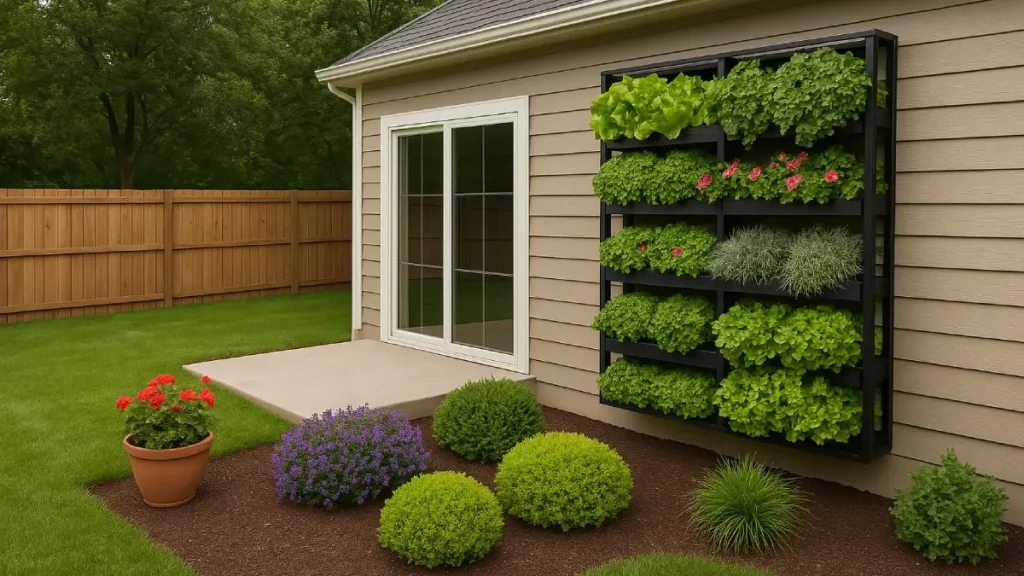
Table of contents
- The Secret Weapon for Amazing Gardens: Properly Prepared Soil for Gardening
- Key Takeaways
- Step 1: Become a Soil Detective! Test and Assess Your Ground
- Step 2: Clear the Decks! Prepare Your Garden Stage
- Step 3: The Magic Ingredient! Boost Your Soil with Organic Matter
- Step 4: Loosen Up! Give Your Soil Room to Breathe
- Step 5: Feeding Time! Managing Soil Nutrients
- Step 6: Solving Soil Puzzles! Tackling Tricky Soil Types
- Step 7: The Grand Finale! Final Touches Before Planting
- Your Garden Adventure Awaits!
- FAQ
Hey garden explorers! Are you ready to grow the most amazing flowers, the juiciest tomatoes, or the crunchiest carrots you’ve ever seen? Guess what? The biggest secret isn’t just sunshine and water – it’s what’s hiding right under your feet! We’re talking about properly prepared soil for gardening, and this week, we’re diving deep into the exciting world beneath the surface to show you exactly how to get your garden bed ready for planting success.
Think of your garden soil like the perfect bed for your plants. If it’s comfy, cozy, and full of yummy food (nutrients!), your plants will be happy and grow big and strong. But if it’s hard, lumpy, or doesn’t have the good stuff plants need, they might struggle.
Getting the soil just right is like giving your future plants a superhero head start! It’s the most important mission you’ll undertake before planting a single seed…
…and trust us, it’s an adventure worth taking. Get ready to transform your patch of earth into a thriving paradise! Let’s grab our shovels and uncover the secrets to properly prepared soil for gardening!
Step 1: Become a Soil Detective! Test and Assess Your Ground
Okay, adventurers, our first mission is to investigate! Before you can make your soil amazing, you need to know what you’re starting with. It’s like being a detective for dirt! The best way to do this is with a soil test. This special test is like a science experiment that tells you super important secrets about your soil (source, source).
What secrets does a soil test unlock?
- pH Level: This sounds tricky, but it just tells you if your soil is more acidic (like lemon juice) or alkaline (like soap). Most vegetables, those yummy things we love to grow, are happiest when the soil pH is just right – somewhere between 6.0 and 7.2 (source). A soil test will tell you your exact number, so you know if you need to adjust it slightly.
- Nutrient Levels: Plants need food, just like us! A soil test reveals which important plant foods (like nitrogen, phosphorus, and potassium) are already in your soil and if you need to add more. It’s like checking the pantry before you go grocery shopping!
- Organic Matter Content: This is the secret ingredient! Organic matter is stuff like old leaves and decomposed plants that makes soil rich and healthy. A soil test tells you how much of this good stuff you have.
You also need to figure out your basic soil type. Get your hands dirty and feel it! Is it:
- Sandy Soil? Feels gritty, like beach sand. Water runs through it super fast, and it doesn’t hold onto food (nutrients) very well.
- Silty Soil? Feels smooth and slippery when wet, almost like flour. It holds water better than sand but can get packed down.
- Clay Soil? Feels sticky and heavy when wet, like modeling clay. It holds lots of water and nutrients but can become hard like a brick when dry, making it tough for roots and water to get through.
- Loamy Soil? This is the jackpot! Loam is a fantastic mix of sand, silt, and clay. It feels crumbly, holds water just right (not too much, not too little), has plenty of space for air, and is packed with yummy organic matter (source). This is the dream soil everyone wants!
Knowing your soil’s secrets (pH, nutrients, type) is the first thrilling step towards creating the perfect home for your plants! Don’t skip this detective work!
Looking to get started on the right path? Check out our handy guides: Gardening Basics: Composting Guide and Organic Fertilizer Guide.
Step 2: Clear the Decks! Prepare Your Garden Stage
Alright, soil detectives, now that you know your soil’s secrets, it’s time to prepare the stage for your garden stars! Before you can start making your soil amazing, you need a clean slate. This means getting rid of anything that doesn’t belong, like pesky weeds or patches of grass (source).
- Weed Warriors: Pull out all the weeds, making sure you get their roots too! If you leave roots behind, those sneaky weeds might just pop back up.
- Grass Be Gone: If your garden spot is currently lawn, you’ll need to remove the sod. You can dig it out or use methods like sheet mulching (covering it with cardboard and compost) to smother it over time.
- Rock Removal: Clear away any large rocks or debris that could get in the way of plant roots or your digging tools.
Think of this step as tidying up your plant’s future bedroom. A clean, clear space means less competition for water and food, giving your chosen plants the best chance to shine!
Supercharge your garden’s success further by learning How to Start a Raised Garden Bed.
Step 3: The Magic Ingredient! Boost Your Soil with Organic Matter
Here comes the real magic! Adding **organic matter** is almost always the answer to improving any soil type. It’s the ultimate soil conditioner.
Think of organic matter as the superfood smoothie for your garden soil! It makes everything better.
What awesome stuff counts as organic matter?
- Compost: This is decomposed kitchen scraps and yard waste – pure gold for your garden!
- Aged Manure: Poop from animals like cows, horses, or chickens (make sure it’s well-rotted, not fresh!).
- Shredded Leaves: Fallen leaves break down beautifully.
Harnessing Renewable Energy for a Sustainable Future: Powering Tomorrow’s World Today
Harnessing Renewable Energy for a Sustainable Future: Powering Tomorrow’s World Today
Estimated Reading Time: 18 minutes
Key Takeaways
- Renewable Dominance: Renewable energy (solar, wind, geothermal) is crucial for sustainability, combating climate change, and replacing finite fossil fuels.
- Tech Advancements: Costs for solar and wind are rapidly decreasing, while efficiency improves. Energy storage is key to overcoming intermittency. Emerging tech like green hydrogen and advanced geothermal expands possibilities.
- Economic & Environmental Wins: Renewables create jobs, enhance energy security, save water, improve air quality, and offer significant long-term economic benefits over fossil fuels.
- Global & Local Action: International agreements (Paris Agreement), corporate commitments (RE100), and individual/community actions (rooftop solar, advocacy) are all driving the transition.
- Overcoming Barriers: Challenges like grid upgrades, permitting, and initial costs remain, but collaborative solutions and smart policies are paving the way forward.
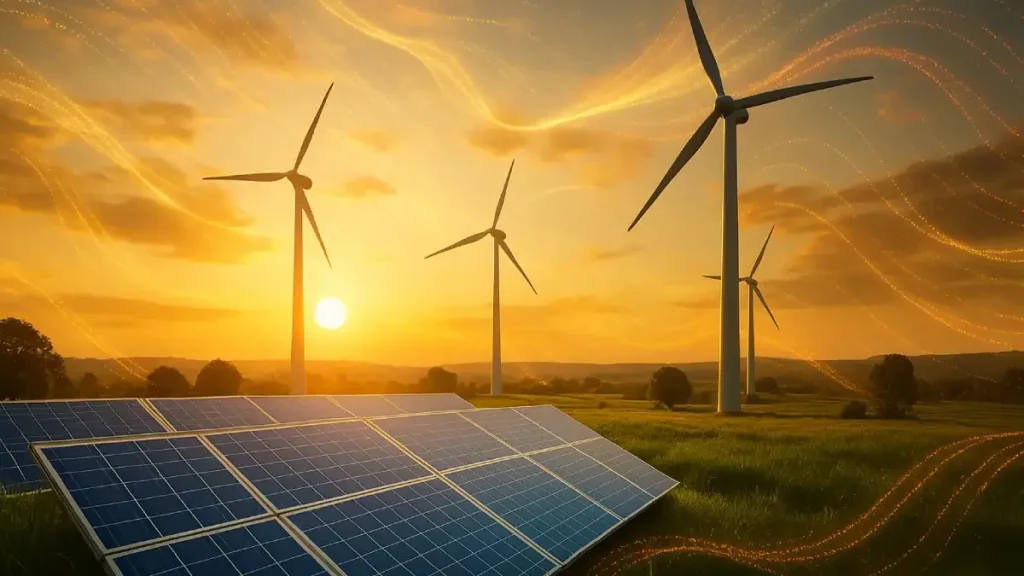
Table of Contents
- Introduction: Understanding Renewable Energy and Sustainability
- The Current State of Renewable Energy Sources
- Solar Power: Harnessing the Sun’s Renewable Energy Potential for Sustainability
- Wind Energy: Power from the Air as a Key Renewable Energy Source
- Geothermal Energy: Using the Earth’s Internal Heat as a Renewable Energy Source
- Energy Storage Solutions: The Key to Unlocking Renewable Energy’s Full Potential
- The Environmental Impact of Renewable Energy and Sustainability
- Economic Benefits: How Renewable Energy Sources Drive Sustainability and Growth
- The Circular Economy of Renewable Energy Technologies for Sustainability
- Emerging Technologies and Innovations in Renewable Energy Sources and Storage
- Global Trends and Policy Landscape Driving Renewable Energy and Sustainability
- Overcoming Barriers to Widespread Adoption of Renewable Energy Sources for Sustainability
- Individual and Community Action: Driving Renewable Energy and Sustainability Locally
- Conclusion: The Renewable-Powered Future and Our Path to Sustainability
- Call-to-Action
- FAQ
1. Introduction: Understanding Renewable Energy and Sustainability
Let’s talk about renewable energy. This is energy that comes from sources that nature keeps refilling, like sunshine, wind, and heat from inside the Earth. These sources won’t run out, unlike coal or oil.
Using renewable energy is key to building a better, lasting future – what we call sustainable development. It helps us live well today without harming the planet for people tomorrow. You can discover more about sustainable tech innovations for a greener future to see how these technologies are shaping our world.
Why is this so important right now?
- Our planet is getting warmer because of climate change, causing big problems like stronger storms and rising seas.
- The fuels we use most, like oil and gas (fossil fuels), are running low and their prices can jump up and down.
- Countries around the world have promised to work together, like in the Paris Agreement, to cut down on pollution and protect the Earth.
“Thinking about sustainability means ensuring the needs of the present are met without compromising the ability of future generations to meet their own needs. Renewable energy is central to this vision.”
In this post, we’ll explore the main types of clean power:
- Solar power (from the sun)
- Wind energy (from the wind)
- Geothermal energy (from Earth’s heat)
- Energy storage solutions (ways to save energy for later)
We will see how these amazing technologies work together to create a path towards sustainability and a healthier planet for everyone. Making the switch to clean, renewable energy is essential for our future.
2. The Current State of Renewable Energy Sources
More and more people and countries are using renewable energy. Clean energy is growing fast all over the world!
- Growth: In recent years, the amount of electricity generated from renewable energy sources like solar and wind has shot up. Many countries are setting records for how much clean energy they use.
- Milestones: Sometimes, whole countries have run completely on renewable energy for hours, days, or even weeks! This shows it’s possible to power our lives without fossil fuels.
- Falling Costs: Getting power from renewable energy used to be expensive. But now, technologies like solar panels and wind turbines are much cheaper. Often, they cost the same or even less than power from coal or gas. This makes clean energy a smart choice for everyone.
- Pandemic Impact: The COVID-19 pandemic caused some delays, but overall, it made people realize how important reliable and clean energy is. Investment in renewable energy sources actually grew stronger during this time.
“The economic case for renewables is now as strong, if not stronger, than the environmental one. Cost parity or even superiority over fossil fuels is accelerating the transition globally.”
The world is clearly moving towards renewable energy. It’s becoming the main way we will power our homes, schools, and businesses in the future.
3. Solar Power: Harnessing the Sun’s Renewable Energy Potential for Sustainability
Solar power uses the sun’s light to make electricity. The main way we do this is with photovoltaic (PV) technology. Think of PV panels as special materials that turn sunlight straight into electrical power.
How Solar Cells Work:
Inside a solar panel are many solar cells. These cells are made of materials like silicon. When sunlight hits the silicon, it excites tiny particles called electrons. These excited electrons start to move, creating an electrical current – just like electricity flowing through a wire. It’s like the sun is knocking electrons loose to make power!
Types of Solar Power Systems:
Solar energy is very flexible. We can use it in lots of ways:
- Residential Rooftop Systems: Many homeowners put solar panels on their roofs to make their own electricity and save money on bills.
- Commercial Applications: Businesses put larger solar systems on their roofs or land to power their buildings and operations.
- Utility-Scale Solar Farms: These are huge fields covered in solar panels, generating large amounts of electricity for the power grid, supplying towns and cities.
- Building-Integrated Photovoltaics (BIPV): This means solar cells are built right into building materials, like roof tiles or windows that generate power.
Costs are Dropping:
One of the best things about solar power is that it’s getting much cheaper. Over the last ten years, the cost of solar panels has fallen by about 85%! This makes solar power affordable for more people and businesses.
Better Technology:
Scientists are always finding ways to make solar panels work better.
- Efficiency: New types of cells, like multi-junction cells (which have multiple layers to catch different light) and perovskites (a new, promising material), can turn more sunlight into electricity. To understand the difference in panel types, see this comparison of monocrystalline vs polycrystalline solar panels.
- Accessibility: Because costs are down and technology is better, solar power is now easier to get. Homeowners, small businesses, big companies, and whole towns can all use the sun’s energy. This helps achieve sustainability goals. For information on making solar power more affordable through government incentives, explore this guide to solar energy tax credits.
Solar energy can be used almost anywhere the sun shines, from small homes to giant power plants. Its ability to scale up or down makes it a vital part of our renewable energy future. It helps reduce our reliance on polluting fuels and contributes greatly to global sustainability.
“Imagine every rooftop, every suitable surface, generating clean power from the sun. That’s the adaptable potential solar energy brings to our sustainable future.”
4. Wind Energy: Power from the Air as a Key Renewable Energy Source
Wind energy captures the power of moving air – the wind – and turns it into electricity. This is done using large machines called wind turbines.
How Wind Turbines Work:
Wind turbines have long blades, like airplane wings. When the wind blows, it pushes the blades, making them spin. This spinning motion turns a generator inside the turbine, which produces electricity. It’s all about converting the wind’s movement energy (kinetic energy) into electrical energy.
Onshore vs. Offshore Wind:
We can build wind farms on land (onshore) or out in the sea (offshore).
- Offshore:
- Winds over the ocean are often stronger and steadier.
- Offshore farms can be much bigger, generating more power.
- They are far from homes, so noise or visual impact is less of a worry.
- Building and maintaining turbines at sea is more expensive and difficult.
- Onshore:
- Building and connecting turbines on land is usually cheaper and easier.
- Maintenance is simpler.
- Finding suitable land away from homes can sometimes be challenging.
Reducing Carbon Footprints:
Wind energy is a clean renewable energy source. It doesn’t burn fuel or release harmful gases. It helps reduce the carbon footprint (the amount of pollution causing climate change) for:
- Industries: Factories and large businesses can use wind power to run their machines cleanly.
- Cities and Towns: Wind farms feed clean electricity into the power grid, reducing pollution for everyone.
- Remote Areas: Wind turbines can provide reliable power to villages or communities far from the main grid.
Improving Wind Technology:
Wind turbines are getting better all the time:
- Bigger Turbines: Newer turbines are massive, some taller than 200 meters (like a 60-story building!). Taller turbines reach stronger winds and capture more energy.
- Smarter Blades: Blade designs are more aerodynamic, catching more wind with less noise.
- AI Maintenance: Artificial intelligence helps predict when turbines might need repairs, preventing breakdowns.
- Floating Platforms: For deep ocean waters where fixed towers aren’t possible, engineers are developing floating platforms for offshore turbines. To explore how wind energy can power your home, see this guide to home wind energy systems.
Wind Energy is a cost-effective way to generate clean electricity. As technology improves, the cost continues to drop, making it competitive with traditional power sources. It’s a vital part of the mix of renewable energy sources needed for a sustainable world.
5. Geothermal Energy: Using the Earth’s Internal Heat as a Renewable Energy Source
Geothermal energy means using the heat that comes from deep inside the Earth. Our planet’s core is incredibly hot (around 2,200°F or 1,200°C on average), and this heat naturally flows outwards. Geothermal systems tap into this constant heat.
Different Ways to Use Geothermal Heat:
We can use Earth’s heat in several ways:
- Direct Use: Hot water from underground can be piped directly to heat buildings, greenhouses for growing food, fish farms, or relaxing hot springs and spas. Discover how geothermal energy offers a sustainable solution for home heating and cooling to learn more.
- Geothermal Heat Pumps: These systems use the stable temperature just below the ground (which is warmer than the air in winter and cooler in summer) to help heat and cool buildings very efficiently.
- Electricity Generation: In certain places, we can use underground steam or very hot water to spin turbines and generate electricity.
“Unlike the sun and wind, the Earth’s internal heat is always ‘on.’ This makes geothermal a uniquely reliable cornerstone for a renewable energy grid.”
How Geothermal Power Plants Work:
There are a few main types of geothermal power plants:
- Dry Steam Plants: These use steam directly from underground reservoirs to turn turbines.
- Flash Steam Plants: These pump very hot water from deep underground into a low-pressure tank, causing it to quickly turn (‘flash’) into steam, which then drives turbines.
- Binary Cycle Plants: These use hot geothermal water (which might not be hot enough to flash into steam easily) to heat a separate liquid with a lower boiling point. This second liquid turns into vapour, which spins the turbines. This allows electricity generation from cooler geothermal resources.
A Reliable Power Source:
One huge advantage of geothermal energy is that it’s always available, 24 hours a day, 7 days a week. The Earth’s heat is constant, unlike sunshine (which disappears at night) or wind (which can stop blowing). This makes geothermal power a great “baseload” power source, providing steady electricity that the grid can rely on.
Where is Geothermal Potential Highest?
Geothermal resources are strongest in areas with volcanic activity or thin parts of the Earth’s crust. This includes:
- The “Ring of Fire” around the Pacific Ocean.
- Rift zones, where tectonic plates are pulling apart (like in East Africa or Iceland).
- Geological “hot spots” (like Hawaii or Yellowstone).
Expanding Geothermal Power:
New technology called Enhanced Geothermal Systems (EGS) is helping us use geothermal energy in more places. EGS involves drilling deep and pumping water down to create underground reservoirs in hot rock, even where natural steam or hot water isn’t easily found. This could greatly expand where we can build geothermal power plants.
Geothermal energy is a reliable and clean renewable energy source. It provides consistent power day and night, making it a valuable part of our move away from fossil fuels.
6. Energy Storage Solutions: The Key to Unlocking Renewable Energy’s Full Potential
Solar and wind power are fantastic renewable energy sources, but they have a challenge: the sun doesn’t always shine, and the wind doesn’t always blow. This is called intermittency. Energy storage solutions are like giant batteries that save extra energy when it’s sunny or windy and release it when it’s needed later. For a detailed look at one key technology, see this complete guide to Tesla Powerwall and home battery solutions.
Why Storage is Crucial:
Energy storage is often called the “missing link” for making renewable energy truly widespread. It allows us to use clean energy whenever we need it, not just when it’s being generated. This makes the power grid more reliable and flexible.
How Storage Helps:
Storage tackles the intermittency problem by:
- Saving excess solar power generated during the day to use at night.
- Storing wind power generated during windy periods for use when the air is calm.
- Ensuring a smooth and constant supply of electricity to homes and businesses.
“If renewables are the engine of the clean energy transition, energy storage is the fuel tank and transmission, allowing that engine to run smoothly anytime, anywhere.”
Types of Energy Storage:
There are many ways to store energy:
- Lithium-ion Batteries: These are the most common type today, used in everything from phones and electric cars to large grid-scale storage systems. They are getting cheaper and better.
- Flow Batteries: These use tanks of liquid electrolytes. They can store large amounts of energy for longer periods than lithium-ion batteries, making them good for grid support.
- Pumped Hydro Storage: This is an older, large-scale method. Water is pumped uphill into a reservoir when there’s extra electricity. When power is needed, the water flows back downhill through turbines to generate electricity.
- Compressed Air Energy Storage (CAES): Air is compressed and stored underground (like in caverns or tanks). When electricity is needed, the compressed air is released to spin turbines.
- Gravity-Based Storage: These clever systems lift heavy weights (like concrete blocks or rail cars) when energy is plentiful and lower them to generate electricity when needed.
- Thermal Storage: This involves storing energy as heat or cold (e.g., molten salts for storing solar heat, or ice for cooling).
Benefits for the Grid and Sustainability:
Energy storage solutions do more than just handle intermittency. They help make our power system work better and support sustainability:
- Grid Stability: Storage helps keep the power grid stable by balancing supply and demand quickly.
- Demand Response & Peak Shaving: It can release stored energy during times of high demand (like hot summer afternoons), reducing the need to fire up expensive and polluting “peaker” power plants that run on fossil fuels.
- Reducing Waste: Storage prevents us from having to “curtail” or waste renewable energy when generation is high but demand is low.
- Off-Grid Power: Batteries combined with solar panels can provide reliable electricity to remote areas without grid connections.
Innovations in energy storage solutions are making them more efficient, longer-lasting, and affordable. They are essential for integrating large amounts of renewable energy into our power systems and creating a truly sustainable energy future.
7. The Environmental Impact of Renewable Energy and Sustainability
Switching to renewable energy has huge benefits for our planet and our health. It’s a cornerstone of environmental sustainability.
Fighting Climate Change:
The biggest benefit is cutting down on greenhouse gases. Fossil fuels release carbon dioxide (CO2) and other gases when burned, trapping heat and causing global warming. Renewable energy sources like solar, wind, and geothermal generate electricity with little to no greenhouse gas emissions. Using more renewables means less pollution warming the planet.
Saving Water:
Traditional power plants (especially coal and nuclear) use massive amounts of water for cooling. Many renewable energy technologies, like solar PV and wind turbines, use very little or no water to operate. This is crucial in areas where water is scarce.
Cleaner Air:
Burning fossil fuels releases pollutants like sulfur dioxide, nitrogen oxides, and particulate matter into the air. These cause smog, acid rain, and serious health problems like asthma and heart disease. Renewable energy doesn’t produce these harmful air pollutants, leading to cleaner air and healthier communities.
“Choosing renewable energy isn’t just about distant climate goals; it’s about breathing cleaner air today and protecting vital water resources for tomorrow.”
Land Use Considerations:
Renewable energy projects do require land, but there are smart ways to manage this:
- Agrivoltaics: This combines solar panels and farming on the same land. Panels can provide shade for crops or animals, and farming can continue underneath or between rows of panels.
- Multiple-Use Wind Farms: Wind turbines often have a small footprint. The land between turbines can still be used for farming or grazing. Offshore wind farms can coexist with fishing or marine conservation areas.
- Wildlife-Friendly Design: Developers are increasingly designing projects to minimize impacts on birds and other wildlife, such as using radar to pause turbines when flocks approach or choosing locations carefully.
Thinking About the Full Lifecycle:
It’s important to consider the environmental impact of making, using, and disposing of renewable technologies.
- Manufacturing: Making solar panels and wind turbines requires energy and materials, some of which need careful sourcing.
- Operation: Once running, most renewables have very low environmental impact.
- Decommissioning: As technologies reach the end of their life, we need good systems for recycling materials like glass, metals, silicon from solar panels, and fiberglass from turbine blades. The industry is working hard on improving recycling processes.
Overall, the environmental benefits of renewable energy far outweigh the impacts. By replacing fossil fuels, renewables drastically cut greenhouse gases, save water, and improve air quality, making our world healthier and supporting long-term sustainability.
8. Economic Benefits: How Renewable Energy Sources Drive Sustainability and Growth
Switching to renewable energy sources isn’t just good for the planet; it’s also great for the economy and brings us closer to sustainability.
Creating Jobs:
The renewable energy sector creates lots of jobs. These jobs are in:
- Manufacturing solar panels and wind turbines
- Installing renewable energy systems
- Maintaining and operating power plants
- Research and development
Studies show that investing in renewable energy sources like solar and wind often creates more jobs per unit of energy (or per dollar invested) than investing in fossil fuels.
Energy Independence and Resilience:
Countries that rely heavily on imported fossil fuels can face unstable prices and supply disruptions. Developing local renewable energy sources like solar, wind, and geothermal means relying on resources available right at home. This increases energy security and makes the economy more resilient.
Saving Money in the Long Run:
While building renewable projects requires upfront investment, they save money over time:
- No Fuel Costs: Sunshine and wind are free! Once built, renewable plants don’t need to constantly buy fuel like coal or gas plants do.
- Lower Maintenance: Technologies like solar panels often have lower maintenance needs than complex fossil fuel plants.
- Reduced Health and Environmental Costs: Cleaner air means lower healthcare costs from pollution-related illnesses. Avoiding climate change damage also saves massive amounts of money.
“Investing in renewables is investing in local jobs, stable energy prices, and a healthier population – an economic trifecta that fossil fuels simply cannot match.”
Opportunities for Developing Nations:
Countries that are still building their energy systems have a chance to “leapfrog” old, polluting fossil fuel infrastructure. They can build modern, clean energy systems based on renewable energy sources from the start, leading to faster, more sustainable development.
Promoting Economic Equity:
Renewable energy can also make energy systems fairer:
- Distributed Ownership: Rooftop solar allows individuals and businesses to own their power generation.
- Community Energy: Local groups can develop and own renewable projects (like community solar farms), keeping benefits and profits within the community.
- Energy Access: Renewables, especially solar with battery storage, can bring reliable electricity to poor or remote communities that the traditional grid hasn’t reached, opening up economic opportunities.
Investing in renewable energy sources powers economic growth, creates jobs, enhances energy security, saves money, and builds a more equitable and sustainable future for everyone.
9. The Circular Economy of Renewable Energy Technologies for Sustainability
A circular economy means keeping resources in use for as long as possible, getting the most value from them, and then recovering and regenerating products and materials at the end of their life. Applying this idea to renewable energy makes it even better for sustainability.
What Circular Economy Means for Energy:
Instead of a “take-make-dispose” model, a circular approach for renewable energy focuses on:
- Using fewer raw materials.
- Designing products to last longer and be easily repaired.
- Reusing components where possible.
- Recycling materials effectively when products reach the end of their life.
Recycling Renewable Technologies:
Work is underway to create strong recycling pathways for key components:
- Solar Panels: These contain valuable materials like glass, aluminum frames, silicon, silver, and copper. Specialized facilities are being developed to recover these materials efficiently so they can be used to make new panels or other products.
- Wind Turbines: Turbine towers are mostly steel, which is easily recycled. Nacelles (the box at the top) contain metals and electronics. Blades, often made of fiberglass or carbon fiber composites, are more challenging, but new methods are being developed to reuse or recycle them (e.g., in cement production or other composite materials).
- Batteries: Recycling batteries, especially lithium-ion batteries used for storage, is crucial to recover valuable materials like lithium, cobalt, nickel, and manganese, and to prevent waste. Pathways for collection and processing are improving rapidly.
“True sustainability requires thinking beyond just clean generation; it demands we manage the entire lifecycle of our energy technologies responsibly, from sourcing to recycling.”
Designing for Circularity:
Manufacturers are starting to design renewable energy technologies with the circular economy in mind:
- Longer Lifespans: Making products more durable so they last longer reduces waste and the need for replacements.
- Easy Disassembly: Designing products so they can be easily taken apart makes repair and recycling simpler.
- Material Recovery: Choosing materials that are easier to recover and recycle, and avoiding hazardous substances.
Industry and Policy Action:
Companies and governments are pushing for circularity in the renewable energy sector through:
- Industry partnerships to develop recycling standards and infrastructure.
- Regulations that require manufacturers to take responsibility for end-of-life products (Extended Producer Responsibility).
- Research into new recycling technologies and circular business models.
Building a circular economy for renewable energy technologies minimizes waste, conserves valuable resources, and reduces the environmental footprint of clean energy even further, enhancing its contribution to long-term sustainability.
10. Emerging Technologies and Innovations in Renewable Energy Sources and Storage
The world of renewable energy sources is constantly evolving, with exciting new technologies and improvements making clean energy even more powerful and accessible. Energy storage solutions are also advancing rapidly.
Cutting-Edge Renewable Developments:
- Floating Solar Farms: Installing solar panels on reservoirs, lakes, or even coastal waters saves land space and can improve panel efficiency due to water’s cooling effect.
- Next-Generation Geothermal: Advanced drilling techniques and Enhanced Geothermal Systems (EGS) aim to unlock vast geothermal resources deep beneath the Earth’s surface, potentially making geothermal power available almost anywhere.
- Green Hydrogen: Using renewable electricity (from solar or wind) to split water into hydrogen and oxygen (electrolysis) produces “green hydrogen.” This clean fuel can be used for transport, industry, or energy storage.
- Building-Integrated Renewables: Beyond solar roof tiles, researchers are developing transparent solar windows that generate electricity, solar roads, and building facades that incorporate wind or solar technology seamlessly.
- Transparent Solar & Solar Roads: Imagine windows that generate power or roads that harvest solar energy! These futuristic ideas are under development.
“Innovation never stops. The next wave of renewable and storage tech promises even greater efficiency, broader application, and deeper integration into our lives.”
Smart Tech Integration:
- Artificial Intelligence (AI): AI helps optimize energy production by predicting weather patterns for solar and wind farms, forecasting energy demand, and managing grid operations more efficiently. It also helps with predictive maintenance for turbines and panels.
- Internet of Things (IoT): Connected sensors and devices allow for real-time monitoring and control of distributed energy resources (like rooftop solar and batteries), creating smarter and more responsive energy systems.
New Frontiers in Energy Storage:
Beyond lithium-ion, researchers are exploring better energy storage solutions:
- Solid-State Batteries: These promise higher energy density (more storage in less space), faster charging, and improved safety compared to current lithium-ion batteries.
- Metal-Air Batteries: These potentially offer very high energy density at lower costs, although technical challenges remain.
- Continued improvements in flow batteries, thermal storage, and other technologies are focused on longer duration storage (days or weeks) needed for a fully renewable grid.
These innovations promise to make renewable energy sources more efficient, versatile, and cost-effective. Combined with advances in energy storage solutions, they are paving the way for a future powered entirely by clean, sustainable energy.
11. Global Trends and Policy Landscape Driving Renewable Energy and Sustainability
The shift towards renewable energy is happening worldwide, driven by international agreements, national policies, business commitments, and community action seeking sustainability.
International Commitments:
- Paris Agreement: This global pact aims to limit global warming, pushing countries to set targets for reducing greenhouse gas emissions, largely through adopting renewable energy.
- National Net-Zero Pledges: Many countries have set goals to reach “net-zero” emissions (balancing emissions produced with emissions removed) by mid-century, requiring massive growth in clean energy.
- Renewable Portfolio Standards (RPS): Many states and countries require utilities to source a certain percentage of their electricity from renewable sources by a specific date.
Corporate Sustainability Movements:
Businesses are playing a huge role in driving demand for renewable energy:
- RE100 Initiative: Hundreds of major global companies have committed to sourcing 100% of their electricity from renewables.
- ESG Investing: Investors increasingly consider Environmental, Social, and Governance (ESG) factors, pushing companies towards sustainability and clean energy investments.
- Corporate Power Purchase Agreements (PPAs): Companies sign long-term contracts directly with renewable energy developers to buy clean power, guaranteeing demand and helping new projects get built.
“From global agreements to boardroom decisions, the message is clear: the future of energy is renewable, and the momentum for sustainability is building across all sectors.”
Community and Local Action:
The transition is also happening from the ground up:
- Energy Cooperatives: Local citizens pool resources to develop and own renewable energy projects, like community solar farms or wind turbines.
- Municipal Renewable Projects: Cities and towns are setting their own ambitious renewable energy goals and investing in local clean power generation.
- Indigenous-Led Renewables: Indigenous communities worldwide are developing renewable energy projects on their lands, creating energy sovereignty and economic benefits.
Future Projections:
Organizations like the International Renewable Energy Agency (IRENA) provide roadmaps showing how the world can transition to a renewable energy-based system. Their analyses suggest that renewables could dominate global electricity grids by 2050, demonstrating the technical and economic feasibility of achieving ambitious sustainability goals through clean energy.
These global trends and policies create a powerful momentum, accelerating investment, innovation, and deployment of renewable energy technologies worldwide, pushing us closer to a sustainable future.
12. Overcoming Barriers to Widespread Adoption of Renewable Energy Sources for Sustainability
While the future of renewable energy sources is bright, there are still challenges to overcome to achieve truly widespread adoption and meet sustainability goals quickly.
Remaining Hurdles:
- Initial Capital Costs: Although the lifetime cost of renewables is often lower, the upfront cost of building solar farms, wind projects, or grid upgrades can still be high compared to existing fossil fuel plants.
- Grid Infrastructure: Our current electricity grids were mostly built for large, central power plants. Integrating large amounts of variable renewables (solar, wind) requires significant upgrades, including new transmission lines and smarter grid management systems.
- Permitting and Regulations: In some places, getting permits to build renewable energy projects can be slow and complex, delaying deployment. Regulations may also need updating to support new technologies and business models.
- Community Acceptance: Sometimes, local communities resist new projects due to concerns about visual impact, noise (for wind turbines), or land use (“Not In My Backyard” or NIMBYism). Early engagement and benefit-sharing are key.
- Technical Challenges: Integrating very high percentages of renewables while ensuring grid reliability requires ongoing technical innovation, particularly in energy storage and grid control.
“The path to 100% renewables isn’t without obstacles. Addressing infrastructure, policy, and community concerns proactively is vital for accelerating the transition.”
Collaborative Solutions:
We can overcome these barriers by working together:
- Public-Private Partnerships: Governments and private companies can collaborate to finance and build necessary infrastructure like transmission lines or large storage projects.
- Innovative Financing: Tools like green bonds (loans specifically for environmental projects), tax incentives, and Energy Service Companies (ESCOs) can help lower upfront costs and attract investment.
- Technology Transfer: Sharing best practices and technologies between countries helps accelerate adoption, especially in developing nations.
- Smart Policy Design: Governments can create stable, forward-looking policies that provide long-term certainty for investors, streamline permitting, and incentivize renewable energy sources. Carbon pricing can also level the playing field with fossil fuels.
- Education and Workforce Training: Building public awareness and training skilled workers (installers, technicians, engineers) is essential for the growing renewable sector.
Addressing these challenges requires effort from governments, industry, communities, and individuals. By tackling these barriers proactively, we can speed up the transition to a clean energy system based on abundant renewable energy sources, ensuring a sustainable future for all.
13. Individual and Community Action: Driving Renewable Energy and Sustainability Locally
The transition to renewable energy isn’t just for big companies or governments. Individuals and communities play a vital role in driving change and advancing sustainability.
Actionable Steps for Individuals:
- Home Renewable Options:
- Rooftop Solar: If you own your home, installing solar panels can reduce your electricity bills and carbon footprint significantly. Look into local incentives and financing options.
- Geothermal Heat Pumps: Consider these highly efficient systems for heating and cooling your home using the Earth’s stable temperature.
- Community Solar: If you can’t install solar on your own roof (e.g., if you rent or your roof isn’t suitable), you may be able to subscribe to a local community solar project and receive credits on your electricity bill.
- Green Power Purchasing: Many utility companies offer options to buy electricity generated from renewable energy sources. Check your provider’s offerings for “green power” or “renewable energy choice” programs.
- Energy Efficiency: Using less energy is the cleanest energy! Improve your home’s insulation, use energy-efficient appliances (like LED lighting), and be mindful of your energy consumption. For tips on making your home more efficient, consider performing a DIY home energy audit. Efficiency complements renewable energy perfectly, and smart thermostats can be a great tool in boosting your home energy efficiency.
“Don’t underestimate the power of individual and local action. Every solar panel installed, every efficiency upgrade made, every voice raised for clean energy policy makes a difference.”
Evaluating Your Options:
When considering renewable energy options, research:
- Your local climate and resources (sunshine hours, wind potential).
- Available government incentives, tax credits, or rebates.
- Reputable local installers and companies.
- Different financing options (purchase, lease, PPA).
Advocacy and Support:
Your voice matters!
- Local Level: Encourage your town or city council to set renewable energy goals, streamline permits for solar, or support community energy projects.
- Regional/National Level: Contact your elected officials to support policies that promote renewable energy, carbon pricing, and investments in clean energy infrastructure.
- Spread the Word: Talk to friends, family, and neighbors about the benefits of renewable energy and share positive stories.
Success Stories:
Countless individuals have lowered their bills and environmental impact with rooftop solar. Communities have banded together to build their own wind or solar farms, keeping jobs and profits local. Citizen advocacy has led to stronger clean energy policies in many regions. Every action contributes to the larger goal of sustainability.
By taking action at home and in our communities, we can all help accelerate the shift to a future powered by clean, reliable renewable energy.
14. Conclusion: The Renewable-Powered Future and Our Path to Sustainability
We’ve explored the incredible potential of renewable energy. From the sun’s power captured by solar panels, to the wind harnessed by turbines, and the Earth’s internal heat tapped by geothermal systems, clean energy sources are transforming how we power our world. Crucially, energy storage solutions are making these sources reliable day and night.
Adopting renewable energy is essential for tackling our biggest challenges: climate change and building a sustainable future. It dramatically cuts the pollution warming our planet, cleans our air and water, conserves precious resources, and drives economic growth by creating jobs and fostering energy independence. Embrace sustainable tech innovations for a greener future to be part of this transformative change.
“The question is no longer if we will transition to renewable energy, but how quickly and effectively we can make it happen for the benefit of all.”
The vision of a future powered mainly by renewable energy is no longer a distant dream. Costs are falling, technology is improving rapidly, and global commitment is growing. The transition away from polluting fossil fuels towards clean, renewable energy is not just necessary for sustainability, it is happening now and becoming unstoppable.
This shift requires effort from everyone – governments setting bold policies, industries innovating and investing, communities developing local projects, and individuals making conscious choices about their energy use. Together, we can accelerate this transition and build a brighter, cleaner, more prosperous, and truly sustainable world powered by renewable energy.
Call-to-Action
Ready to be part of the clean energy future? Here’s how you can contribute:
- Investigate: Explore renewable energy options for your home or business. Could solar panels work for you? Is community solar available? Can you switch to a green power plan?
- Support: Advocate for policies at the local, state, and national levels that encourage renewable energy adoption, grid modernization, and carbon reduction. Let your elected officials know you support clean energy.
- Share: Talk about the benefits of renewable energy with your friends, family, and colleagues. Share articles like this one and help spread awareness.
To learn more about specific technologies, incentives in your area, or ways to get involved, check resources from your local government, utility provider, or reputable environmental organizations. Let’s work together to harness the power of renewable energy for a better tomorrow.
FAQ
Q: What is the most significant benefit of switching to renewable energy?
A: The most significant benefit is drastically reducing greenhouse gas emissions that cause climate change. Renewables provide power with little to no emissions, unlike fossil fuels. Additional major benefits include cleaner air, water conservation, energy independence, and job creation.
Q: Are renewable energy sources reliable enough to power the entire grid?
A: Individually, solar and wind are variable (intermittent). However, when combined with geographically diverse deployment, complementary sources like geothermal and hydropower, and crucially, energy storage solutions (like batteries), a reliable grid powered predominantly by renewables is achievable and increasingly becoming a reality.
Q: Is renewable energy more expensive than fossil fuels?
A: While some renewable projects require significant upfront investment, the costs of solar and wind power have fallen dramatically. In many places, building new solar or wind is now cheaper than building new fossil fuel plants. Furthermore, renewables have zero fuel costs, making their long-term operational costs lower and more predictable.
Q: What can I do personally to support renewable energy if I can’t install solar panels?
A: You can support renewables by: opting into a green power program through your utility, subscribing to community solar if available, improving your home’s energy efficiency (which reduces overall demand), and advocating for pro-renewable policies by contacting your elected officials.
Q: What happens to solar panels and wind turbines at the end of their lifespan?
A: The industry is actively developing and improving recycling processes. Solar panels contain valuable materials like glass, aluminum, and silicon that can be recovered. Wind turbine blades are more challenging, but methods for recycling or repurposing the materials (like fiberglass) are advancing. Promoting a circular economy for these technologies is a key focus for sustainability.
-

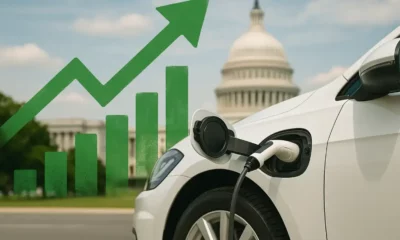

 Mobility8 months ago
Mobility8 months agoHow Government Policies Impact Electric Vehicle Adoption: A Comprehensive Analysis
-



 Sustainability5 months ago
Sustainability5 months agoBallerina Farm Protein Powder: The Ultimate Farm-to-Shake Solution
-

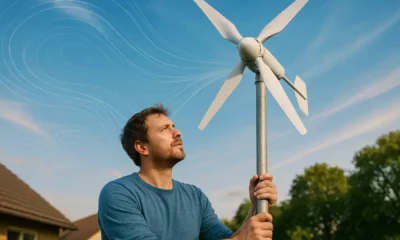

 Sustainability8 months ago
Sustainability8 months agoHome Wind Energy: The Complete Guide to Powering Your Green Home with Wind Turbines
-

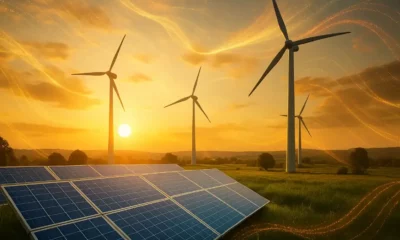

 Sustainability8 months ago
Sustainability8 months agoHarnessing Renewable Energy for a Sustainable Future: Powering Tomorrow’s World Today
-



 Technology8 months ago
Technology8 months agoGet Ready! The Future of Esports Tournaments & New Games Are Here!
-

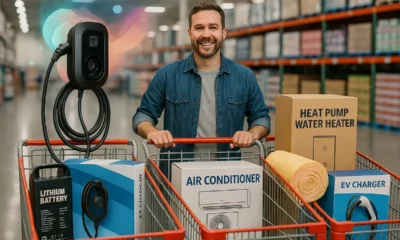

 Mobility8 months ago
Mobility8 months agoEV Charging 101: Costs, Home Stations, and How to Save with Rebates



![what to do if car is totaled [state]](https://nowee.org/wp-content/uploads/2025/09/image_0-80x80.webp)
![diminished value claim [state]](https://nowee.org/wp-content/uploads/2025/09/image_0-1-80x80.webp)



